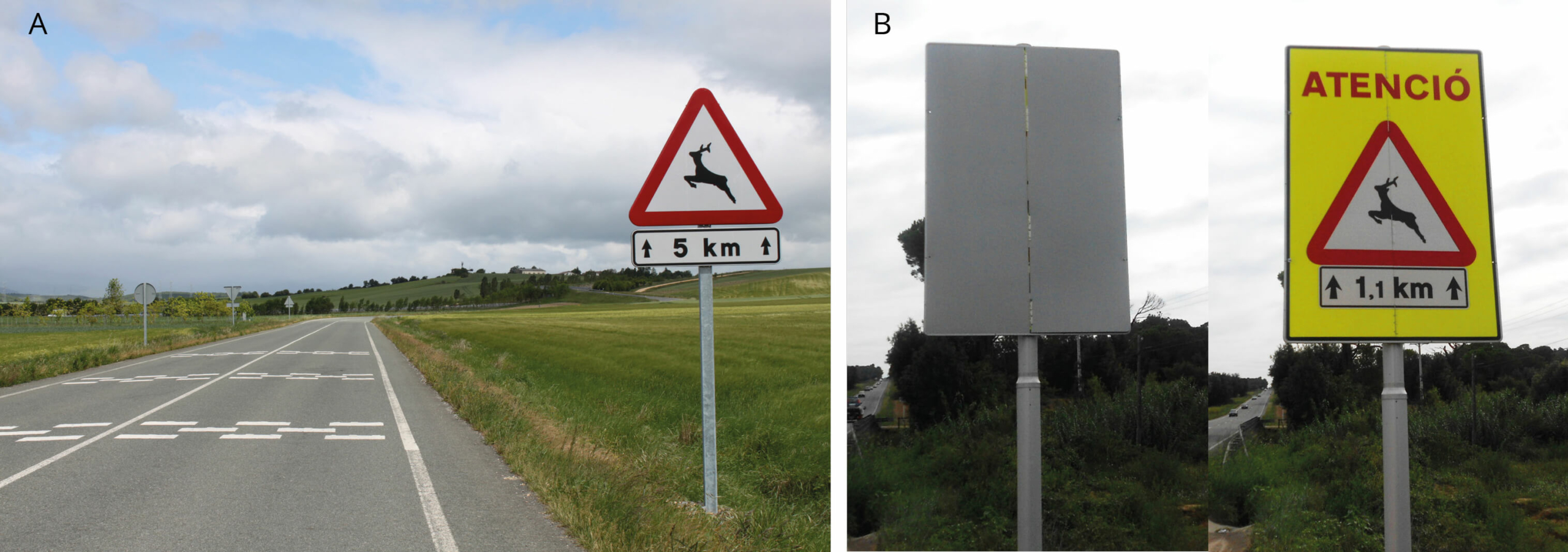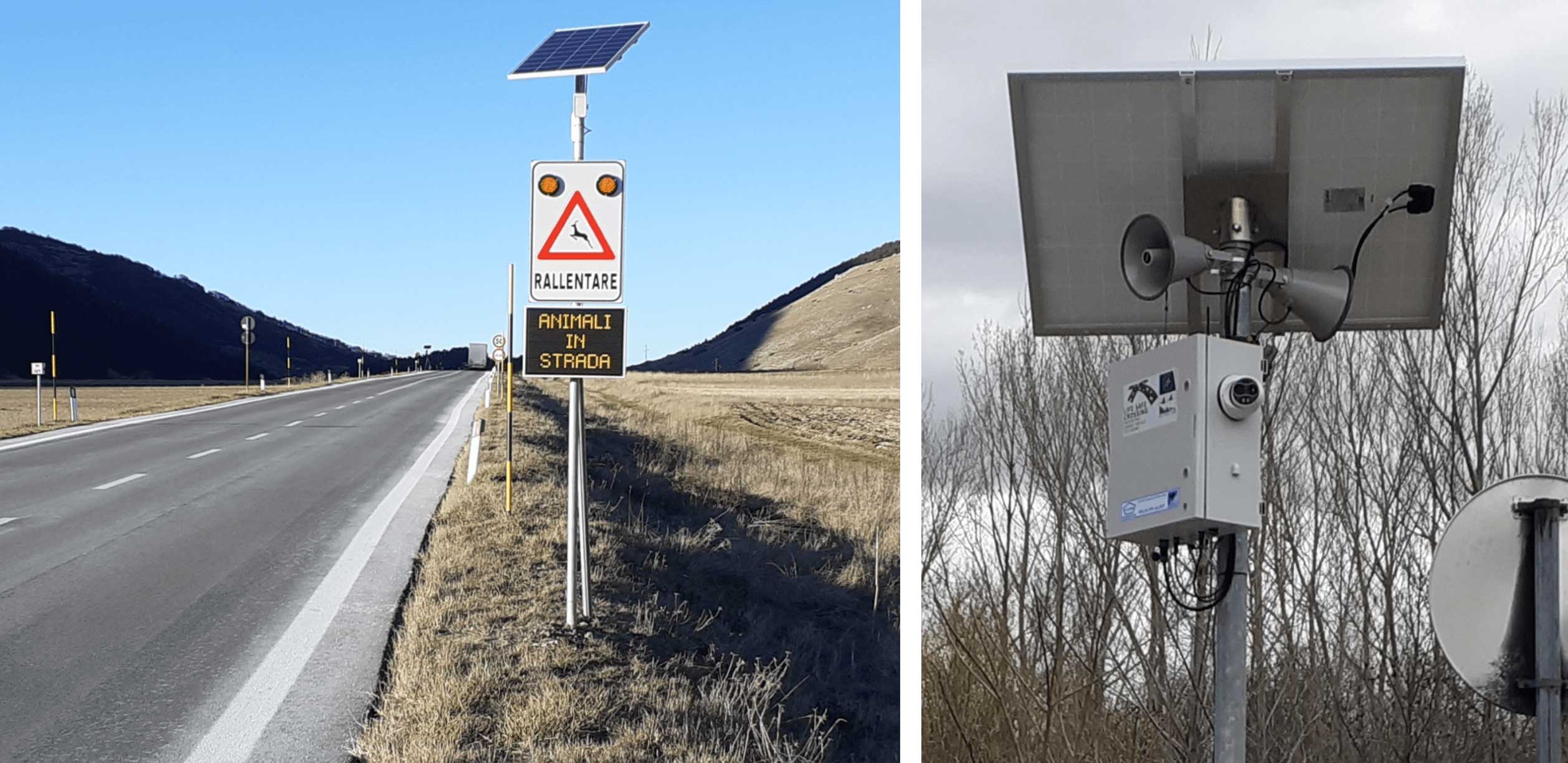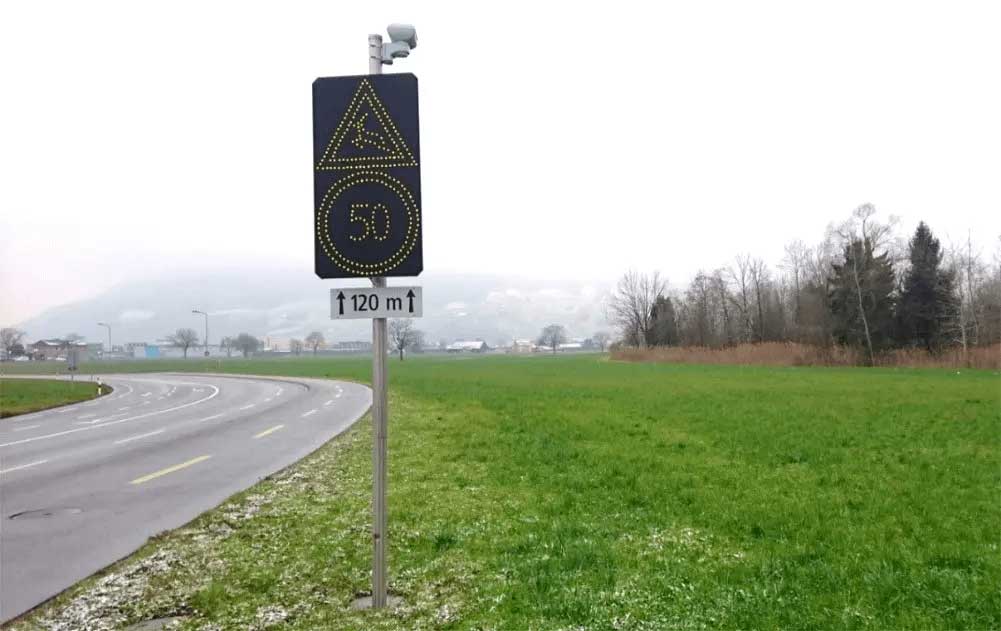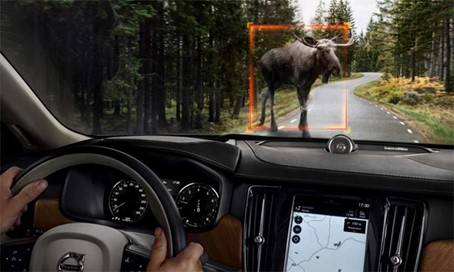Warning signs aim to influence driving behaviour, reduce speed and increase attention, thus resulting in a reduction in the risk and severity of animal-vehicle collisions (AVC). Several studies have shown that vehicle speed and drivers’ attention are two important factors in wildlife-vehicle collisions. A reduction in speed provides more reaction time, braking distance and reduces the energy of an impact.
Further studies are required to establish the effectiveness of many devices described in this section.
Standard and temporary wildlife traffic signage
RATIONALE. Standard and temporary wildlife traffic signage
Wildlife traffic signs are one of the most used mitigation measures, aiming to alert drivers about the potential presence of wild animals on the roads and thereby reducing the risk for AVC. A literature review of the topic is provided by Huijser et al. (2015). Standard (static) wildlife warning signs are more commonly used, although they are generally less effective as drivers become habituated and tend to ignore them (Found & Boyce, 2011; Bullock et al., 2011; Huijser et al., 2015; van der Grift et al., 2017). Enhanced wildlife warning signs, which are bigger, transmit more specific messages, or include eye-catching details, may initially be more noticeable to drivers, but suffer from the same habituation effect as standard signs (Huijser et al., 2015).
Temporary wildlife warning signs are more specific as to where and when AVC risks are elevated, which makes them more reliable for drivers and hence more effective (Sullivan et al., 2004; Gagnon et al., 2010; Huijser et al., 2015). Active warning signs triggered by Animal Detection Systems (ADS) display even more acute information about the immediate accident risk. Active devices are more effective than temporary and standard warning signs, especially if combined with temporary speed limitations.
Both static, temporary and active warning signs can be applied to roads with low to intermediate traffic volumes and low to intermediate speeds, where drivers are able to reduce speed suddenly or even stop vehicles to avoid animals (Bhardwaj et al., 2022). On motorways with high speed and busy traffic, wildlife warning signs may be pointless or even hazardous. Here, only the physical separation of wildlife and traffic by fences and wildlife passages is recommended from a traffic safety perspective (Huijser et al., 2015; van der Grift et al., 2017).
Standard wildlife traffic signage is placed in areas where collisions often occur and consequences for human safety are significant. Studies indicate that there is no corresponding reduction in accidents involving wildlife, so these standard signs do little more than provide a legal protection to road operators (see Rationale box. Standard and temporary wildlife traffic signage). Road users quickly get used to such signs, especially if they are present all year round and if the driver uses that stretch of road frequently (Figure 5.3.1A). Drivers ignore permanent signs probably because the sign doesn’t often correspond with real presence of an animal close to the road.
The combination of a wildlife warning sign with a speed limit is slightly more effective. The effectiveness is further enhanced if signs are marked with flashing lights or a flashing speed limit sign, lit only during periods of high target species activity.
Temporary warning signs, activated only during critical periods of the year, in locations with high risk of collision, have shown higher effectiveness (in terms of AVC reduction) than permanently installed signs. These temporary signs could be reinforced with flashing lights or reflective panels (Figure 5.3.1B).

Warning signs activated by Animal Detection Systems (ADS)
Warning signs associated with animal detection systems (ADS) are devices which include sensors to detect animals of different size and activate warning signs to drivers. ADS may also trigger deterrents to scare away animals when vehicles approach and are described in Section 5.4 – Wildlife deterrents. They can only be used on relatively short road sections such as hotspots of animal-vehicle collisions or fence openings.
- ADS require very particular road verge features and must be frequently checked and maintained, as many factors such as growing vegetation can affect their functionality (see Chapter 7 – Maintenance).
- ADS may rely on either active light barriers, passive infrared sensors, thermal cameras or radars to detect wildlife movements close to infrastructure (Figure 5.3.2). The power supply is provided by a battery and a small built-in solar module.
- Where ADS are installed they activate warning signs or panels informing drivers that when a flashing light or message appears it means an immediate collision risk because an animal is close to the road and could cross at any moment. It is recommended that a speed reduction sign accompanies the warning.
- Wildlife warning devices with ADS are being improved to reduce false positives (activations not caused by the presence of an animal) with a corresponding increase in reliability.
Animal detection systems can also be combined with a doppler radar that detects approaching vehicles and their speed to trigger light or noise deterrents that are intended to keep animals off the road. A driver warning may be activated when an animal is detected, and if the speed of the approaching vehicle is higher than a given threshold. Messages such as ‘Animal on the Road’ or ‘Slow down’ could be activated. Optionally they can be fitted with animal deterring sounds or signals (Figure 5.3.3). Similar systems are also being tested to deter ungulates on train lines. Studies have demonstrated an increased effectiveness when sounds are used that animals associate with a real danger, such as human voices or dogs barking (see Section 5.4 – Wildlife deterrents).

Anti-collision systems in vehicles
Some car manufacturers have already installed systems in their vehicles to detect people and animals on the road, which assist in braking and speed control, and prevent accidents. Such intelligent technologies are quickly gaining a foothold as essential components in the development of automated and autonomous vehicles (Figure 5.3.4).
Anti-collision systems may use radar or passive and active infrared cameras to detect potential upcoming collision risks. Algorithms can be employed for image recognition and differentiation of species as well as appropriate response behaviour. Combined with automated braking systems that outperform the driver’s own reaction, collision risks for traffic are likely to be significantly reduced.
New technologies will probably enable vehicles to communicate with others and share information about the presence of potentially hazardous wildlife near the roadway. Early warnings from other vehicles will help to prepare Artificial Intelligence systems and drivers to react in the most appropriate way. It is however, still unclear how well these vehicle based multi-sensor prevention systems may perform and whether they could replace infrastructure based installations. Most likely in-vehicle systems will complement safety measures on minor roads where physical mitigation such as fencing, crossing structures may not be recommended. Whether such systems also would be useful in preventing collisions with small animals is unknown. It depends on the capacity of sensors to detect small-sized animals.

